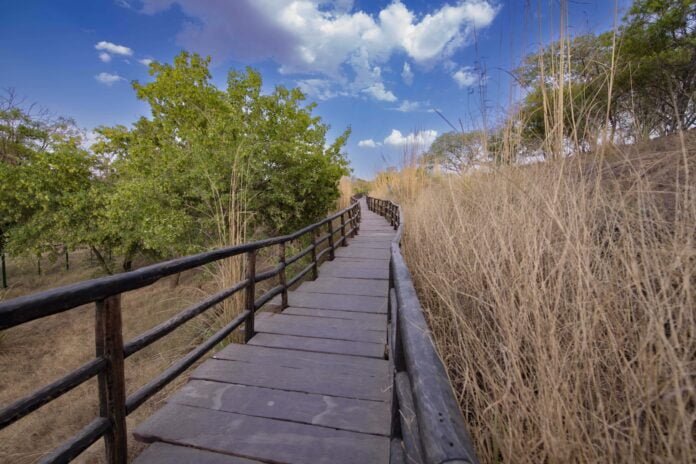
Kishan Bagh Jaipur, a hidden gem in the heart of Rajasthan’s capital city, is a beautiful and attractive tourist destination that offers a unique oasis experience. Once a barren piece of land, it has now been transformed into a lush green paradise, thanks to the efforts of the Jaipur Development Authority and the visionary environmentalist, Pradeep Krishen. Spread over 30 acres, Kishan Bagh boasts a variety of natural desert landscapes, including mesmerizing sand dunes, crystal-clear water bodies, and a diverse range of flora and fauna.
Historical Background:
Kishan Bagh’s history can be traced back to Prince Jagat Singh, son of King Mirza Man Singh of Amer, who built a palace around the area. The palace, named Mariam Mahal after his beloved wife Mariam, was surrounded by a beautiful garden, known as Kishan Bagh. Over time, the garden fell into neglect, and an unsuccessful attempt to turn it into a cactus garden led to significant losses.
Revival and Transformation:
In January 2016, the Jaipur Development Authority sought the expertise of environmentalist Pradeep Krishen, known for his successful restoration of the Rao Jodha Desert Rock Park in Jodhpur. Together with architect Golak Khandual, they embarked on the ambitious project of rejuvenating Kishan Bagh into a natural desert landscape. Through their efforts, the garden was reinvigorated, with native plants and trees reintroduced to the area, along with soil from richer habitats, ensuring the return of local flora and fauna.
The Splendor of Kishan Bagh:
Today, Kishan Bagh is a sight to behold, attracting a growing number of tourists and locals alike. The park’s key feature is the natural shrubland, locally known as ‘Roee,’ which offers visitors a unique opportunity to experience the desert ecosystem up close. A raised walkway of 600 meters and a sand dune walk of 1.2 kilometers allow visitors to explore the exhibits on sand, rocks, and plants, providing valuable insights into the region’s natural history.
Special Sand Dunes of Kishan Bagh:
The sand dunes of Kishan Bagh are particularly remarkable, given their location in the Thar Desert, one of the most arid regions in the world. Shaped by the winds, these vast and beautiful dunes showcase a mesmerizing array of shapes and shades. Moreover, the sand dunes are home to various wildlife species, including endangered ones like the Indian wolf and the great Indian bustard, making them an essential conservation area.
Timing and Entry Fee:
Kishan Bagh is open to visitors during specific hours throughout the year. In winter (November to March), the timing is from 8 AM to 5.30 PM, while in summer (April to October), it is from 6 AM to 6.30 AM. The entry fee for adults is Rs. 50, while students can enjoy free or in minimal charge of Rs 25 only.
How to Reach Kishan Bagh:
Kishan Bagh is conveniently located just 15 km from Jaipur and is easily accessible by various modes of transportation. Visitors can reach the park by car, public buses, or taxis, making it a convenient day trip destination.
Dos and Don’ts:
– Wear comfortable walking shoes and cotton clothes, and don’t forget a hat to protect from the sun.
– Avoid bright colors, opting for green, khaki, or camouflage outfits if interested in birdwatching.
– Carry water and some snacks for a more enjoyable experience.
– Seek help from naturalists at the ticket counter for a free guided tour.
Kishan Bagh Jaipur has risen from the pages of history to become a thriving tourist spot and a testament to the successful restoration efforts of dedicated individuals like Pradeep Krishen and Golak Khandual. With its natural beauty, desert landscapes, and diverse flora and fauna, Kishan Bagh offers a unique experience that captivates the hearts of visitors and locals alike. Whether one is a nature enthusiast, a history buff, or a casual traveler, Kishan Bagh is an excellent destination to explore and appreciate the wonders of Rajasthan’s Thar Desert.

